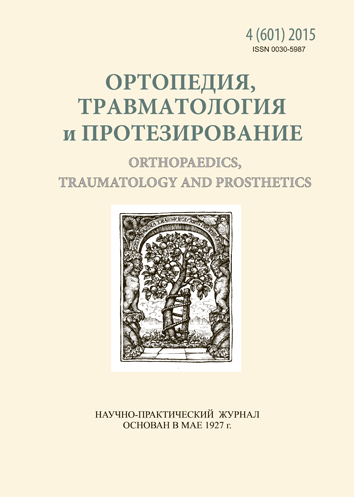Investigation of realization mechanism of shoulder dislocation in patients with hill-sachs lesion using method of mathematic modeling
DOI:
https://doi.org/10.15674/0030-59872015437-42Keywords:
shoulder joint, instability, Hill-Sachs lesion, shoulder-slipAbstract
Differences between atmospheric and intraarticular pressure during shoulder movement provoke pull-effect that stabilize shoulder joint. Due to impression lesion of humerus head the congruence of articular surfaces and stabilizing effect are disturbed, that leads shoulder instability. Goal: to determine the force intensity, that provides pull-effect, and efficacy of its influence under the conditions of shoulder instability combined with Hill-Sachs lesion; to investigate the mechanism of realization of humerus head dislocation in the conditions of the incongruence of shoulder joint surfaces. Methods: mathematic modeling of the stabilizing effect of shoulder joint due to the differences between atmospheric and intraarticular pressure was performed. The method of calculation of vacuum cup for industrial work was used as a background for the calculation of force providing pull-effect in shoulder. Mathematic modeling of the probability of realization of shoulder dislocation under the conditions of Hill-Sachs lesion was performed using the method for determination of catching of tappet gear. Results: it was determined that the mechanism providing pull-effect in shoulder joint is a factor of its primary stabilization under conditions of muscle relaxation. Efficacy of the force that provides pull-effect in shoulder lasts if the area of scapular joint surfaces at least twice the size of defect area on the joint surface of humeral head. It was proved that impressed defect is a clue mechanism for the realization of shoulder dislocation. The main indices for the realization of this mechanism are an angle of inclination of humeral head defect in the point of probable contact and speed of movement in shoulder joint. The stability of shoulder joint remains if the angle of defect inclination is more then 60º and area of defect is not more then 1/2 of sacpular joint surface.References
- Gadzhiev M. M. The state of the intra-articular pressure in case of habitual dislocation of the shoulder / M. M. Gadzhiev // Orthopedics, traumatology and prosthetics. — 1976. — № 12. — P. 55–56.
- Kozyrev Yu. G. Industrial robots. Guide / Yu. G. Kozyrev. ― M.: Mashinostroenie, 1988. — 392 p.
- The problem of strength in biomechanics: textbook for technical. and Biol. spec. Universities / I. F. Samples, I. S. Adamovich, I. C. barer [and others]. — M.: Higher school, 1988. — 311 p.
- Handbook of mechanical engineering. — M.: GNTI machine-building literature, 1954. — Vol. 1. — 567 p.
- Tyazhelov A. A. Peculiarities of clinical manifestations of shoulder instability / Tyazhelov A. A. // Orthopedics, traumatology and prosthetics. — 1999. — No. 2. — P. 115–119.
- Bone loss in anterior instability / E. Itoi, N. Yamamoto, D. Kurokawa, H. Sano // Curr. Rev. Musculoskelet. Med. — 2013. — Vol. 6. — P. 88–94, doi: 10.1007/s12178-012-9154-7.
- Burkhart S. S. Traumatic glenohumeral bone defects and their relationship to failure of arthroscopic Bankart repairs: significance of the inverted-pear glenoid and the humeral engaging Hill-Sachs lesion / S. S. Burkhart, J. F. De Beer // Arthroscopy. — 2000. — Vol. 16. — P. 677–694, doi:10.1053/jars.2000.17715.
- Hudak P. L. Development of an upper extremity outcome measure: the DASH (disabilities of the arm, shoulder and hand) [corrected]. The Upper Extremity Collaborative Group (UECG) / P. L. Hudak, P. C. Amadio, C. Bombardier // Am. J. Ind. Med. — 1996. — Vol. 29 (6). — P. 602–608, doi: 10.1002/(SICI)1097-0274.
- In vitro kinematics of the shoulder following rotator cuff injury /
- A. E. Kedgley, G. A. Mackenzie, L. M. Ferreira [et al.] // Clin. Biomech. — 2007. — Vol. 22. — P. 1068–1073.
- Quantitation of in situ contact areas at the glenohumeral joint: a biomechanical study / L. J. Soslowsky, E. L. Flatow, L. U. Bigliani [et al.] // J. Orthop. Res. — 1992. — Vol. 10. —
- P. 524–534, doi: 10.1002/ jor.1100100407.
- The insertional footprint of the rotator cuff: an anatomic study / A. S. Curtis, K. M. Burbank, J. J. Tierney [et al.] // Arthroscopy. — 2006. — Vol. 22 (6). — Article 609.e1, doi: http://dx.doi.org/10.1016/j.arthro.2006.04.001
- The shape of the inferior part of the glenoid: a cadaveric study / P. E. Huysmans, P. S. Haen, M. Kidd [et al.] // J. Shoulder Elbow Surg. ; 2006. — Vol. 15. — P. 759–763, doi: 10.1016/j.jse.2005.09.001.
Downloads
How to Cite
Issue
Section
License
Copyright (c) 2015 Olexiy Tyazhelov, Marianna Bitsadze, Mykhaylo Karpinsky

This work is licensed under a Creative Commons Attribution 4.0 International License.
The authors retain the right of authorship of their manuscript and pass the journal the right of the first publication of this article, which automatically become available from the date of publication under the terms of Creative Commons Attribution License, which allows others to freely distribute the published manuscript with mandatory linking to authors of the original research and the first publication of this one in this journal.
Authors have the right to enter into a separate supplemental agreement on the additional non-exclusive distribution of manuscript in the form in which it was published by the journal (i.e. to put work in electronic storage of an institution or publish as a part of the book) while maintaining the reference to the first publication of the manuscript in this journal.
The editorial policy of the journal allows authors and encourages manuscript accommodation online (i.e. in storage of an institution or on the personal websites) as before submission of the manuscript to the editorial office, and during its editorial processing because it contributes to productive scientific discussion and positively affects the efficiency and dynamics of the published manuscript citation (see The Effect of Open Access).














